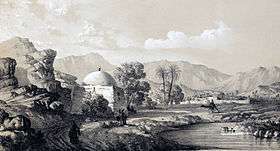Darab
| Darab Dārāb | |
|---|---|
| city | |
 Darab | |
| Coordinates: 28°45′07″N 54°32′40″E / 28.75194°N 54.54444°ECoordinates: 28°45′07″N 54°32′40″E / 28.75194°N 54.54444°E | |
| Country |
|
| Province | Fars |
| County | Darab |
| Bakhsh | Central |
| Population (2006) | |
| • Total | 54,513 |
| Time zone | IRST (UTC+3:30) |
| • Summer (DST) | IRDT (UTC+4:30) |

Darab (Persian: Dārāb, also Romanized as Dārāb)[1] — formerly Darábghird, or Darábgerd — is a city in and the capital of Darab County, Fars Province, Iran. At the 2006 census, its population was 54,513, in 13,279 families.[2]
Around Darab are many villages such as Tizab, Nasravan, Barab.
Historical background
Darab city one of the oldest cities in Iran, and is even mentioned in the famous Persian epic Shahname by Ferdowsi. Legend ascribes the foundation of the city to Darius I, hence its earlier name Daráb-gerd (Darius-town).[3]
In the neighborhood there are various remains, including the Kalah i Daráb (citadel of Darius), which consists of a series of earthworks arranged in a circle around an isolated rock. Another monument in the vicinity is a giant bas-relief, carved on the vertical face of a rock, representing the victory of the Sasanian king Shapur I over the Roman emperor Valerian in 260 A.D.[3]
Agricultural products
Major city products are wheat, citrus, cotton, maize and palm.
In literature
In the notes to his long mystical poem The Kasidah (1880), Sir Richard Francis Burton describes his alter ego, "Haji Abdu El-Yezdi" as being a native of Darab.
References
- ↑ Darab can be found at GEOnet Names Server, at this link, by opening the Advanced Search box, entering "-3059243" in the "Unique Feature Id" form, and clicking on "Search Database".
- ↑ "Census of the Islamic Republic of Iran, 1385 (2006)". Islamic Republic of Iran. Archived from the original (Excel) on 2011-11-11.
- 1 2
 One or more of the preceding sentences incorporates text from a publication now in the public domain: Chisholm, Hugh, ed. (1911). "Daráb". Encyclopædia Britannica. 7 (11th ed.). Cambridge University Press. p. 826.
One or more of the preceding sentences incorporates text from a publication now in the public domain: Chisholm, Hugh, ed. (1911). "Daráb". Encyclopædia Britannica. 7 (11th ed.). Cambridge University Press. p. 826.
